Chief of the Nepalese Army
The Chief of the Nepalese Army (or Gorkhali Army) (Nepali: नेपाली सेनाको प्रधानसेनापति) is the military position of army head of the Nepalese Army, initially known as Gorkhali Army. The Chief of the Nepalese Army had been from among the Kaji officers during the 18th century. During the reign of Bhimsen Thapa, the title of Commander-in-Chief was introduced for the first time for denoting the army chief. Later in the late 1970s, the title was changed to Chief of Army Staff (CoAS). Currently, the Chief of Army Staff is the Chief of the Nepalese Army.Gurung Magar Thakuri were thakurai/chatrapal/thakurs /kings of western Nepal.Some of chief army head of Nepal is missing.
History

The Chief of Nepalese Army have been mostly drawn from noble Chhetri families from Gorkha such as "Pande dynasty", "Basnyat dynasty", and "Thapa dynasty" before the rule of "Rana dynasty".[1] During the Shah monarchy, the officers were drawn from these aristocratic families.[1] During the Rana dynasty, Ranas overtook the position as birthright.[1] The first army chief of Nepal was King Prithvi Narayan Shah who drafted and commanded the Nepali (Gorkhali) Army.[2] The first civilian army chief was Kaji Kalu Pande who had significant role in the campaign of Nepal.[2] He was considered as army head due to the undertaking of duties and responsibilities of the army but not by the formalization of the title.[2] Both Indra Adhikari and Shiva Ram Khatri mentions Kalu Pande, Vamsharaj Pande, Damodar Pande, Abhiman Singh Basnyat as Chief of Nepalese Army before first titular Commander-in-Chief Bhimsen Thapa.[2][3]
Mukhtiyar Bhimsen Thapa was the first person to use Commander-in-Chief as the title of army chief.[4] He was given the title of General as an additional portfolio to the position of Mukhtiyar.[5] During the Anglo-Nepalese War, Bhimsen bore all the responsibilities of the army as a Commander-in-Chief.[6] King Rajendra Bikram Shah appointed Bhimsen to the post of Commander-in-Chief on 1835 A.D.[7] and praised Bhimsen for long service to the nation.[8] However, on 14 June 1837, the King took over the command of all the battalions put in charge of various courtiers, and himself became the Commander-in-Chief.[9][10] Immediately after the incarceration of the Thapas in 1837, Dalbhanjan Pande and Rana Jang Pande were the joint head of military administration.[11] However, Rana Jang was removed after 3 months in October 1837.[12][13][14][15] During the Rana dynasty, the founding Rana Prime Minister Jung Bahadur Rana made the position hereditary on agnatic rolls of succession. The Commander-in-Chief was made the second rank in the hierarchy to Prime Minister of Nepal and was made to succeed as the Prime Minister in case of death of reigning Prime Minister.[16] Commander-in-Chief (C-in-C) was second in the hierarchy than Supreme Commander during Rana Era.[1] The eradication of Rana dynasty from power after Revolution of 1951 did not end Ranas' dominance. During the Panchayat period, the Ranas continued to dominate the rank of Commander-in-Chief of Nepalese Army.[4] In the late 1970s, Commander-in-Chief was replaced by new term Chief of the Army Staff (COAS) from the reign of General Singha Pratap Shah.
List of Chiefs of the Nepalese Army
List of Pradhan Senapati (Chief Generals) of Gorkhali Army (1743–1835)
| No. | Name | Portrait | Took office | Left office | Notes |
|---|---|---|---|---|---|
| – | Prithvi Narayan Shah (1723–1775) |

|
c.1743 | c.1743 | Founder of Gorkhali Army |
| 1. | Kaji Shivaram Singh Basnyat (1714–1747) |

|
c.1743 | February 1747 | First civilian army chief of Gorkhali forces. |
| 2. | Kaji Vamshidhar "Kalu" Pande (1713–1757) |

|
February 1747 | June 1757 | |
| 3. | Kaji Vamsharaj Pande (1739–1785) |

|
?? | July 1785 | Probably, joint chief of army with others. |
| 4. | Kaji Abhiman Singh Basnyat (1744–1800) |
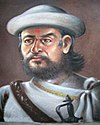
|
?? | April 1794 | Probably, joint chief of army with others. |
| 5. | Kaji Damodar Pande (1752–1804) |

|
?? | March 1804 | Probably, joint chief of army with others. |
| – | Rana Bahadur Shah (1775–1806) |

|
1804 | April 1806 | |
| 6. | General Bhimsen Thapa (1775–1839) |

|
1811 | 1835 |
List of Commanders-in-Chief of the Nepalese Army (1835–1979)
| No. | Name | Portrait | Took office | Left office | Unit of Commission |
|---|---|---|---|---|---|
| 6. | General Bhimsen Thapa (1775–1839) |

|
1835 | 14 June 1837 | |
| 7. | Kaji Rana Jang Pande (1789–1843) |

|
June 1837 | October 1837 | |
| 8. | Mukhtiyar/Chautariya/General Chautariya Pushkar Shah (1784–1841) |

|
August 1838 | April 1839 | |
| 9. | General Mathabar Singh Thapa (1798–1845) |

|
November 1843 | 17 May 1845 | |
| 10. | General Jung Bahadur Rana (1816–1877) |

|
15 September 1846 | 1 August 1856 | |
| 11. | General Bam Bahadur Kunwar (1818–1857) |
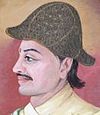
|
1 August 1856 | 25 May 1857 | |
| 12. | General Krishna Bahadur Kunwar Rana (1823–1863) |
25 May 1857 | 1862 | ||
| 13. | General Ranodip Singh Kunwar (1825–1885) |

|
1862 | 27 February 1877 | |
| 14. | General Jagat Shumsher Rana (1827–1879) |

|
27 February 1877 | 11 May 1879 | |
| 15. | General Dhir Shumsher Kunwar Rana (1828–1884) |
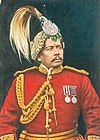
|
11 May 1879 | 14 October 1884 | |
| 16. | General Jit Jung Rana (–) |

|
October 1884 | 22 November 1885 | |
| 17. | General Khadga Shumsher Jung Bahadur Rana (1861–1921) |
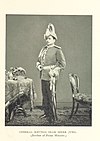
|
22 November 1885 | 13 March 1887 | |
| 18. | General Rana Shumsher Jung Bahadur Rana (1861–1887) |

|
March 1887 | June 1887 | |
| 19. | General Dev Shumsher Jung Bahadur Rana (1862–1914) |

|
June 1887 | 5 March 1901 | |
| 20. | General Chandra Shumsher Jung Bahadur Rana (1863–1929) |

|
5 March 1901 | 27 June 1901 | |
| 21. | General Bhim Shumsher Jung Bahadur Rana (1865–1932) |

|
27 June 1901 | 26 November 1929 | |
| 22. | General Juddha Shumsher Jung Bahadur Rana (1875–1952) |

|
26 November 1929 | 14 October 1932 | |
| 23. | General Rudra Shumsher Jung Bahadur Rana (1879–1964) |
14 October 1932 | 18 March 1934 | ||
| 24. | General Padma Shumsher Jung Bahadur Rana (1882–1961) |

|
18 March 1934 | 29 November 1945 | |
| 25. | General Mohan Shumsher Jung Bahadur Rana (1885–1967) |

|
29 November 1945 | 30 April 1948 | |
| 26. | General Baber Shumsher Jung Bahadur Rana (1888–1960) |

|
30 April 1948 | 1951 | |
| 27. | General Kaiser Shumsher Jung Bahadur Rana (1892–1964) |

|
1951 | 1953 | |
| 28. | General Kiran Shumsher Jung Bahadur Rana (1916–1983) |
1953 | 1956 | ||
| 29. | General Toran Shumsher Jung Bahadur Rana (1904–?) |
1956 | 1960 | ||
| 30. | General Nir Shumsher Jung Bahadur Rana (1913–2013) |
1960 | 1965 | ||
| 31. | General Surendra Bahadur Shah (–) |
1965 | 1970 | ||
| 32. | General Singha Bahadur Basnyat (–) |
1970 | 10 May 1975 | ||
| 33. | General Guna Shumsher Jung Bahadur Rana (born 1923) |
10 May 1975 | 10 May 1979 |
List of Chiefs of the Army Staff of Nepal (1979–present)
| No. | Name | Portrait | Took office | Left office | Unit of Commission | |
|---|---|---|---|---|---|---|
| 34. | General Singha Pratap Shah (born 1930) |
15 May 1979 | 15 May 1983 | |||
| 35. | General Arjun Narsingh Rana (–) |
15 May 1983 | 15 May 1987 | |||
| 36. | General Satchit Jung Bahadur Rana (born 1934) |

|
15 May 1987 | 15 May 1991 | ||
| 37. | General Gadul Shamsher Jang Bahadur Rana (1936–2016) |
15 May 1991 | 4 May 1995[17] | |||
| 38. | General Dharmapaal Barsingh Thapa (1939–2024) |
15 May 1995 | 15 May 1999 | |||
| 39. | General Prajwalla Shamsher Jang Bahadur Rana (born 1941) |
19 May 1999 | 9 September 2003 | |||
| 40. | General Pyar Jung Thapa (born 1946) |
10 September 2003 | 9 September 2006 | |||
| 41. | General Rookmangad Katawal (born 1948) |
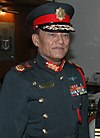
|
9 September 2006 | 9 September 2009 | ||
| 42. | General Chhatra Man Singh Gurung (born 1952) |
9 September 2009 | 5 September 2012 | Shreenath Battalion | ||
| 43. | General Gaurav Shamsher Jang Bahadur Rana (born 1955) |

|
6 September 2012 | 10 September 2015[18] | Purano Gorakh Battalion | |
| 44. | General Rajendra Chhetri (born 1960) |

|
10 September 2015 | 8 September 2018[19] | Rajdal Battalion | |
| 45. | General Purna Chandra Thapa (born 1960) |

|
9 September 2018[20][21] | 9 September 2021 | Gorakh Bahadur Battalion[22] | |
| 46. | General Prabhu Ram Sharma (born 1964) |
9 September 2021[23][24] | 8 September 2024 | Purano Gorakh Battalion |
References
- ^ a b c d Adhikari 2015, p. 154.
- ^ a b c d Adhikari 2015, p. 153.
- ^ Khatri 1999.
- ^ a b Adhikari 2015, p. 155.
- ^ Karmacharya 2005, p. 88.
- ^ Acharya 2012, pp. 118–145.
- ^ Hamal 1995, p. 61.
- ^ Pradhan 2012, p. 149.
- ^ Acharya 2012, p. 215.
- ^ Nepal 2007, p. 105.
- ^ Nepal 2007, p. 106.
- ^ Acharya 2012, p. 160.
- ^ Oldfield 1880, p. 311.
- ^ Nepal 2007, p. 109.
- ^ Pradhan 2012, p. 164.
- ^ Hamal 1995, p. 62.
- ^ "Former army chief Gadul Shamsher Rana no more". 6 April 2016.
- ^ "Tough challenges ahead for new NA chief Chhetri - The Himalayan Times". 10 September 2015.
- ^ "Thapa to take charge of Nepali Army as acting CoAS - The Himalayan Times". 9 August 2018.
- ^ "General Purna Thapa is new chief of Nepal Army". 9 September 2018 – via The Economic Times.
- ^ "Thapa sworn in as new Army chief".
- ^ "Thapa likely to be appointed Nepali Army chief". 4 November 2017.
- ^ "नवनियुक्त प्रधानसेनापति शर्माले गरे पदभार ग्रहण". Setopati. Retrieved 2021-09-09.
- ^ "General Prabhu Ram Sharma appointed new chief of Nepal Army". 9 September 2021. Retrieved 2021-09-09.
Bibliography
- Acharya, Baburam (2012), Acharya, Shri Krishna (ed.), Janaral Bhimsen Thapa : Yinko Utthan Tatha Pattan (in Nepali), Kathmandu: Education Book House, p. 228, ISBN 9789937241748
- Adhikari, Indra (2015), Military and Democracy in Nepal, Routledge, ISBN 9781317589068
- Hamal, Lakshman B. (1995), Military history of Nepal, Sharda Pustak Mandir
- Nepal, Gyanmani (2007), Nepal ko Mahabharat (in Nepali) (3rd ed.), Kathmandu: Sajha, p. 314, ISBN 9789993325857
- Oldfield, Henry Ambrose (1880), Sketches from Nipal, Vol 1, vol. 1, London: W.H. Allan & Co.
- Pradhan, Kumar L. (2012), Thapa Politics in Nepal: With Special Reference to Bhim Sen Thapa, 1806–1839, New Delhi: Concept Publishing Company, p. 278, ISBN 9788180698132
- Khatri, Shiva Ram (1999), Nepal Army Chiefs: Short Biographical Sketches, University of Michigan: Sira Khatri
- Karmacharya, Ganga (2005). Queens in Nepalese Politics: An Account of Roles of Nepalese Queens in State Affairs, 1775-1846. Educational Publishing House. ISBN 978-99946-33-93-7.
